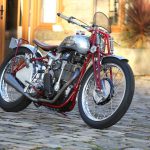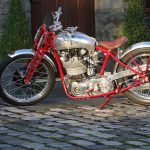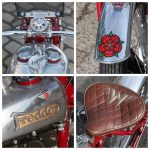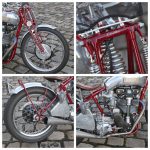Exclusive ride on the 1950s American-style hotrod built with Norton parts and much ingenuity by Britain’s top Classic race tuner, Fred Walmsley
Calling a bike a Bobber nowadays has become as ubiquitous a term as Café Racer or Street Tracker, as successive manufacturers rush to jump on a potentially profitable commercial bandwagon. But Fred Walmsley, 71, is old enough to remember the genuine Bobbers first time around, after they were invented in the USA post-WW2, and after toying with the idea of building one for the past 50 years, he’s finally gone and done so in the well-equipped workshop attached to his farmhouse outside Preston, on the edge of the Lancashire fells. Except, it’s not a Bobber, but The Fredder – as in, built by Fred, not Bob, using an array of Norton parts to create a cut-‘n’-shut streetlegal vintage racer with heaps of attitude.
You can also read: Conferderate FA-13 Fighter Bomber road test
A closer look at the 2018 Dakar Rally line-up

This Anglo-American concoction sits well with the 1952 straight-six ¾-ton Chevy pickup it shares the Walmsley farmyard with, or the 1931 Model A Ford hotrod nestling in a nearby stable that’s been channeled and chopped to produce a totally authentic 5.7-litre flathead V8 speedster. Yet Walmsley – aka ‘Kentucky Fred’, on account of the KFC franchises in nearby Blackburn that he made a good living from before selling up to concentrate 100% on fettling motorcycles of a certain age – is best known for the succession of Manx Norton and Matchless G50 classic racers he’s furnished over the past 25 years for the likes of Barry Sheene, Wayne Gardner, John McGuinness and other stars of the past and present to ride. Together, they’ve won dozens of Historic races around the world from the UK to Australia with Walmsley-prepped bikes, all of which were prepared in that same farmhouse workshop. So, what’s with the Fredder, er – Fred?

“I’ve always liked building stuff like this,” admits Walmsley, “ever since in the early ‘60s when at 14 years old I built what you’d now call a mountain bike out of my pushbike. My mum has a picture of me with this creation, complete with wide handlebar, moped wheels, big tyres and stuff like that. I had it in my mind for a long time to build a Bobber-type hotrod to ride around on, but it wasn’t till I came across an ideal donor bike that I finally got going properly on it, about two years ago.”
Powered by a replica of Geoff Duke’s 1952 works dohc Manx Norton engine delivering 55 bhp at the rear wheel at 8,000 rpm, fitted with good-looking Alfin big-fin cylinder barrel
That bike was a 1952 ex-police Model 19 Norton, a 596cc ohv single built from 1933 onwards by the Birmingham-based brand, primarily as a sidecar tug – hence the capacity, and the four inch-plus stroke. But Walmsley didn’t plan to use its ultra-longstroke 83 x 113mm pushrod motor as the basis for his Bobber – sorry, Fredder – he just needed the extra height in the frame delivered by the tall engine to install a longstroke Manx Norton cammy motor, suitably revamped for road use without being detuned. Well, you wouldn’t expect the king of Classic race tuners to stick just an ordinary Norton ohv engine in it, would you?

“I raced a Formula 3 Cooper car for a few years, and it had a longstroke Manx Norton engine with the Alfin big-fin cylinder they all used back in the ‘50s, because the engine was stuck behind the driver, so there wasn’t such a good flow of cooling air as in a bike,” explains Fred. “I really liked the look of the engine with that meaty cylinder finning. I think the barrels look really weary on the original-type long-stroke Nortons, whereas the big-fin engine reminds me of a bulldog puffing its chest out! In fact, I’ve had my own barrels made with slightly bigger finning still, so as to match the larger longstroke cylinder head with the long cambox. I think the way the Fredder’s engine has come out, it’s a piece of mechanical art that’s beautiful to look at – even more than the later short-stroke motors.” Hard to argue with that, isn’t it?
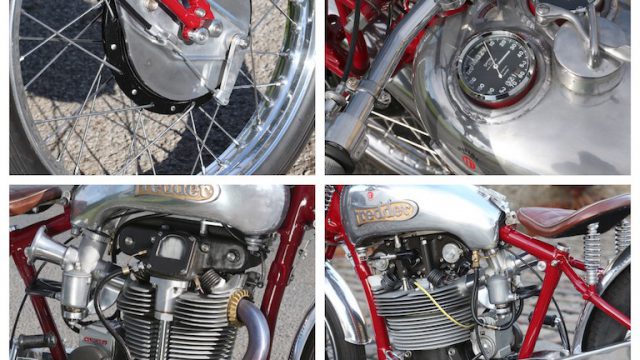
To show off this mechanical centrefold pinup, Walmsley has created a replica of the works Manx Norton engine that reigning World champion Geoff Duke defended his title on in 1952. To do so, he took a set of replica longstroke (pre-‘53) Manx Norton crankcases cast in magnesium, surmounted by the special cylinder barrel he had made with extra finning, which has a Nikasil chromed bore. But rather than retain the 79 x 100mm dimensions of the 500cc customer version of that engine, he chose the ‘square’ 86 x 86 mm layout of Duke’s works engine as adopted on later short-stroke Manx singles. To achieve this, Fred used a modern one-piece crankshaft with white metal plain bearings and Cosworth shells, carrying a Carrillo steel rod surmounted by a forged Omega piston delivering a 13:1 compression ratio. “The piston’s a bit of a hybrid design, because it’s got the same hemi shape as the longstroke Norton one, but with a squish band on the side like on a G50,” says Fred. “But it works really well, though I had to get ten of them made as a minimum order. So we’ve got some spares!” The longstroke Manx cylinder head is a one-off casting furnished by Preston neighbour Molnar Engineering, with a special combustion chamber to suit the hybrid piston, but stock valve angles to match the cambox. Walmsley then hand ported the head to his own spec, but the nimonic valves used in the Fredder are actually slightly smaller than those in even a standard longstroke Manx engine, let alone a bigger-bore works motor.

“Most of the gains I’ve had with replica Manx and G50 engines have come through the exhaust side of the cylinder head, and the exhaust system,” says Fred. “I think Nortons lost their way with that side of things, because for them it was all about inlet tracts and compression ratio and valve overlap, and all that. I think the valves were too big in the Manx engines to give the right harmonics, and especially the exhaust valve and the exhaust port. I’ve actually downsized from stock on both inlet and exhaust valves, but the actual volume and area of the exhaust ports on Manx engines that I tune are probably 50% less than what Norton was doing. They’re very small – people look at them and say, that won’t work. OK, then – but just try and catch my bikes up out on the track!”

Those smaller valves carry hairpin springs – often a good recipe for oil getting splashed on your boots and even the rear tyre. “I’ve used hairpin springs because they look nice, and these don’t pass a lot of oil,” says Fred. “A good friend of mine was in charge of the tool rooms at British Aerospace here in Preston before he retired, and he’s an old-time jig borer. So instead of reaming the pusher bushes and that, we made a fixture and Dave bores them for me on a really accurate milling machine – we get them to tenths of a mil. They’re not tight either, they’re just right.”

With sparks provided by a Lucas 2M TT magneto with 34.5º advance – there are no lights fitted, which is OK in the UK if the vehicle is only ridden in daylight hours – the Fredder’s engine produces a very healthy 55 bhp at the rear wheel at 8,000 rpm on UK Dynojet importer Frank Wrathall’s dyno literally just up the road from the Walmsley workshop. That’s helped by the fact that Fred’s longstroke motors use trick race cams, which originally emanated from Reg Dearden’s, the legendary Manchester dealer who often acted as the back door to the Norton factory race shop. “When Dearden finished with racing, a lot of his stuff went to a friend of mine, Eric Biddle,” says Fred. “He had a big collection of Nortons and loads of factory parts that came from Dearden’s, including boxes and boxes of cams. The cam designs and profiles I use came from the stuff that ended up with Eric. They’re experimental Norton cams, but I’ve matched them up, and they go very well.”

The high 13:1 compression necessitates running the Fredder on a blend of Avgas and super unleaded, same as on his race bikes. Walmsley runs a 1⅜-inch (35mm) Amal GP2 carb on the Fredder with a pair of SU remote float chambers, preferring the smaller carb over the 1½-inch items on his race engines on the grounds of rideability for road use. But the choice of twin SU float chambers is mainly aesthetic. “The carb manifold is from my Cooper car,” he admits. “I think it just looks nice, with the big works Norton bellmouth fitted, and a float chamber on either side like we had on the car to counter centrifugal cornering forces. But I have petrol only in one of them, to be honest – there’s two just to look good!” Walmsley plans to take the Fredder racing this year by fronting up to a ‘run what you brung’ straight line Sprint meeting with it in the back of his Chevy pickup, hoping to break the 130 mph mark the bike is presently geared for on the road.

The Fredder’s transmission comes courtesy of a 5-speed Mick Hemmings gearbox with belt primary drive, combined with a dry Speedway-style NEB clutch, and a kickstart – although with that high a compression, you’re better off with a run-and-bump classic-era racing start despite the compression release lever that Fred Walmsley has fitted to facilitate starting. But he plans to fit an electric start shortly, sourced via French Vincent guru Patrick Godet who’s already converted most of the V-twins he supplies to electric start. But that will entail fitting a battery and an alternator, thus depriving the Fredder of its stripped-down simplicity. Still, he can then fit lights for when he’s caught out late riding home after dark…

But coax the Fredder into life from cold, and you’re rewarded with a fabulous crack from the megaphone exhaust, even though it’s fitted with a nominal DB-killer which doesn’t however seem to make much difference! It won’t idle until the engine is really hot – so you must perforce keep blipping the light-action throttle to warm it up. Heaven! That very trick exhaust is pretty divine, too, comprising a full titanium pipe made by another of Fred’s local Preston mates. Ben Sargeant Fabrications works for nearby Paul Bird Motorsport in repairing all the crash damage on the factory Ducati with which Shakey Byrne won the 2017 British Superbike championship. So when the Panigale racer comes in for the exhaust to be fixed after Shakey’s crashed it, Ben saves all the scrap metal – so the Fredder’s exhaust is actually made from the offcuts from Shakey’s Superbike! But the actual design of the pipe is down to Fred Walmsley: “I worked out the dimensions and the shape of the megaphone, based on the one on the longstroke Norton I developed which won the 2016 Goodwood Revival, and which has the same cams in it as the Fredder,” he says. “Ben’s father is a silversmith, and he’s excellent at shaping metal to make stuff. He’ll make a cup to go over the reverse cone to silence it a bit more, but we need Shakey to crash again so we can finish it off in titanium!” Ben Sargeant himself also produced the 12-litre alloy fuel tank, and the oil tank side-mounted on the right.

That 55 bhp output is pretty tidy, and is actually slightly more powerful than the longstroke 79 x 100 mm engine in Walmsley’s 1953 Featherbed Norton that TT maestro John McGuinness and Classic ace Glen English rode to victory for him in the 2016 Goodwood Revival. This made 53 bhp on the back wheel at 6,500 rpm, whereas the Fredder’s engine peaks at 8,000 revs with 2 bhp more on tap – more than the later short-stroke Manx Nortons built up to 1962 made, as delivered. “The 86 x 86 mm ‘square’ Manxes didn’t usually rev as high as that,“ says Fred, “They only went to 7,200 rpm because of the cams and exhaust Norton used. But they will rev higher reliably, as we do today for quite a bit extra power.”
Rigid frame with no rear suspension started out life as a 1952 Model 19 ohv Norton police bike, suitably cut-‘n’-shut by Walmsley to house tall Manx Norton engine
The completed engine is installed in the ex-police Model 19 Norton’s rigid frame that’s devoid of rear suspension, after its cradle was cut out and repositioned, and the front downtube bent forward for extra clearance. A set of custom engine plates completes the installation, after Fred took a photo of the frame with the engine fitted, printed it on A4 paper and then sketched in the tanks for Ben Sargeant to make. “I always wanted it to be a rigid bike, so as to be more authentic,” explains Fred, “because I remember as a kid in the late ‘50’s and’ 60’s the bobbers were all rigid back then. Triumph does a Bobber nowadays which looks rigid but isn’t, but I didn’t want to go down that street – I just wanted to keep it as it really was.”

A modified Norton girder fork with twin works keeper springs and a larger control spring carries a 21-inch front wheel matched to the 19-inch rear, both fitted with Spanish-made Morad alloy rims by Steve Lomas at Five-One Wheels. Up front there’s a replica 1938 eight-inch (203mm) Manx Norton SLS/single leading-shoe drum brake cast entirely in magnesium by another Fred friend, fellow Classic racer Ian Bain whose Nortons of all ages are unfathomably quick, and who not only cast the front brake components in a home-made foundry in his back garden, but also produced the very distinctive cast Fredder tank badges, the rear numberplate, and both filler caps for the oil and fuel tanks. The seven-inch (178mm) rear SLS drum is a production item from Molnar, though, also in magnesium. Together, they haul down a bike weighing 143kg with oil but no fuel, with the weight carried with a 47/53% rearwards bias in the 1395mm/55in wheelbase.
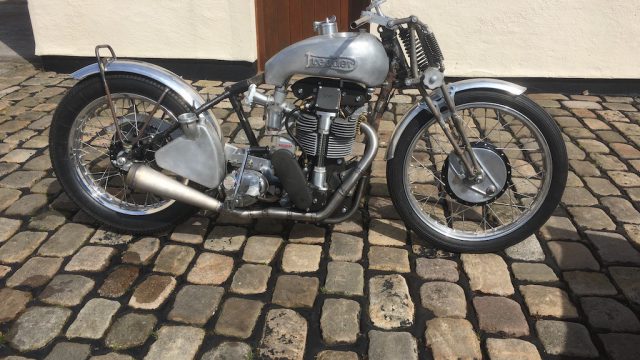
But why a 21-inch front wheel, Fred – especially since the choice of performance tyres is pretty limited? The Fredder carries a skinny 3.00 x 21 Avon Speedmaster Mk.II up front, matched to a slightly chunkier 4.00 x 19 Heidenau at the rear. “Basically, it’s for looks,” admits Fred, “but also to find a bit more ground clearance with the Manx engine sitting so low in the chassis, because it’s such a tall unit to squeeze in under the top frame tube. Weight distribution is the main thing on a special, and a lot of people overlook it, so then when they ride the bike after it’s complete, it won’t handle. I’ve been really fortunate – you know that phrase about standing on the shoulders of giants? Well, I’ve done that, because Barry Sheene taught me a lot about weight distribution, and some of the stuff he taught me is actually in this bike. Barry raced my Manx with a four-kilo weight ballast on the front down tubes, whereas everyone else was trying to take weight off. I made sure the Fredder’s engine was in the right place at the stage we were modifying the Model 19 frame to suit the twincam motor, so thanks to Barry I reckon it handles OK. What did you think of it?”

Well, I actually had two chances at answering that question, after the Fredder made its public debut last June at the Goodwood Festival of Speed, where Fred used it as paddock transport. Pitted right next door to Team Walmsley in the Paddock, I couldn’t resist his invitation to give his creation a run on the Hill, and riding it down to the start gave me a strong clue I was going to enjoy this – it had brisk acceleration from low down as shown on the separate speedo and rev-counter sitting in the face of the fuel tank, in best Transatlantic style. Sure enough, after slipping the clutch quite hard to get it off the line with the very long first gear on the Hemmings ‘box – no need to worry about burning out the bullet-proof Speedway race clutch in doing so! – I was rewarded with meaty acceleration once the carburation cleaned up above 3,000 revs. Except for a slight flutter of megaphonitis around 5,000 rpm, the Fredder’s Norton engine drove seamlessly hard and strong to the 7,800 rpm mark, where I shifted up through the gears on the crisp, precise one-up right-foot change without using the clutch, all to the glorious beat from the megaphone exhaust. It felt punchy and torquey, but also quick – going past The House I slotted fifth gear, and a quick glance at the speedo as I began to anchor up for the second-gear left by the Champagne tent told me I was already doing 95 mph. Impressive!

Unfortunately, that was as good as it got, for the Fredder spluttered to a halt 200 metres further on – out of gas! Fred was beside himself with apologies – so, nothing to do but to take him up on his offer to visit him in Lancashire to ride the bike through the country lanes and villages of his and the Fredder’s home turf. Doing so allowed me to get a better handle on the rigid frame’s suitability for real world riding, and I must admit it surprised me, albeit thanks mainly to the comfy, well-sprung saddle supplied by Get Leathered in Manchester who also upholstered it to incorporate the ‘Flying W’ emblem. This partially mitigated the bumps and thumps of riding at speed over unmanicured country road surfaces very different than Goodwood’s smooth tarmac. But the Fredder’s girder fork steered well – if rather slowly, thanks to the 21-inch front wheel – even over road rash like ripples and ruts, so that although it felt tautly sprung and not especially compliant, it had adequate damping for serious street-rodding such as the Fredder is well capable of.
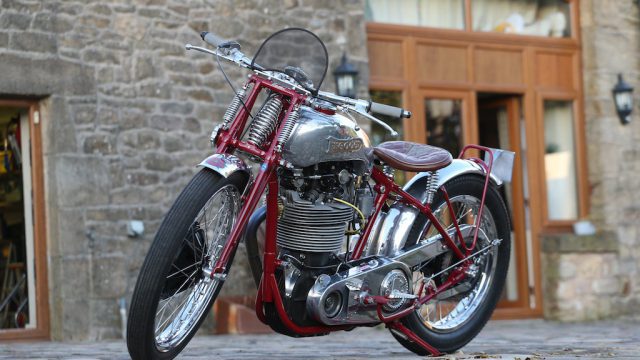
Indeed, while this is basically a point and squirt device, it’s a stirring ride that will have you smiling to yourself every moment you’re in the saddle. For this is a cool bike to look at that’s also such fun to ride – it has modern performance, but vintage looks. The wide, flat handlebar delivers a Bobber’s typical upright stance – it’s a rational real world riding position that feels purposeful, yet also relaxed. Together with the skinny 3.00 x 21 front tyre, the wide handlebar which Fred found at an autojumble delivers light, precise steering. And the brakes are actually pretty good despite being so small by modern standards, though using the hefty engine braking from that high compression motor takes care of any missing bite from the pair of single leading-shoe drums. But you must be ready to fan the clutch lever if you over-exaggerate on the revs after downshifting – no slipper clutch here to stop the rear wheel chattering!
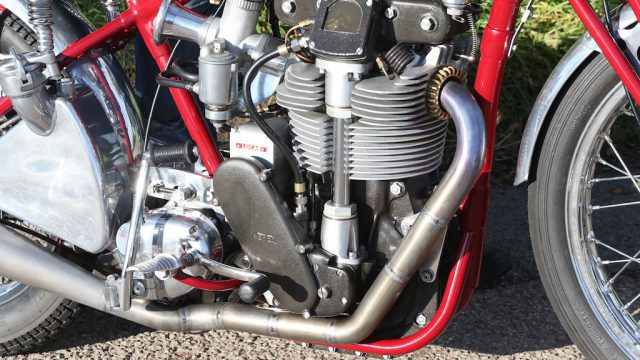
So, what now – is the exquisitely created Fredder to be a glorious one-off special, or will there be a Fredder Two, or even Three? “I’m collecting bits to make a Fredder Two with a Matchless G50 engine for myself, and I’ve already refused £50 grand for this Norton bike – twice!” admits Fred. “But it would have to be priced in that region if I were going to build a customer Fredder. It takes ages to make them, and there’s all these magnesium parts and the titanium pipe, and so on. You can’t get people to do nice specialised stuff on the cheap anymore these days, and rightly so. But I would build others like this for people who were serious, and understood what’s involved in creating them.”
Exquisite example of Classic-era special building, with copies available for the £50,000 Fred Walmsley has twice refused to part with the Fredder for
In which case, the Fredder’s return visit to Goodwood for the Revival race meeting last September to act as Team Walmsley’s paddock transport would surely have acted as a fine piece of PR to the assembled enthusiasts of period transport – even if it wasn’t built before the 1967 cutoff date for doing so, it surely looks as if it was! “I rode it to the Goodwood cricket match the day before the meeting began, because the traffic was really busy,” says Fred. “But when I got to the gate house and turned in, much to my surprise there were no cars at all in front of me. So I thought I’d give it some welly running past the golf links on either side, and I got it right on the megaphone – so well I thought they’d hear it at the cricket match and wonder, what’s this coming here? Anyway, there was a dip in the road and when I cleared it I just glanced down at the speedo, and we were doing 90 mph – so that’s all right, then! I parked up by the Pavilion, and Lord March – well, the Duke of Richmond as he is now – he saw me and came over to look at the bike before delivering his pep talk to the assembled riders and drivers, He’s a proper enthusiast for all kinds of bikes and really knows his stuff, so he looked the Fredder over and just loved it. Then he asked, “How well does it go?” So I put my hand on his shoulder and said, “Sorry, Charles, I’ve got to apologise to you – I’ve just done 90 mph coming up here from the gate!” He smiled broadly and said, “Good man! When can I have a ride on it?!” So I might take it down to Goodwood in the spring for him to take a turn on it up his drive….”
Good man, indeed – and what a good bike.













